Financial Reporting: Users, Regulatory Bodies, and Reporting Standards
VerifiedAdded on 2019/12/03
|7
|1615
|477
Report
AI Summary
This report delves into the crucial aspects of financial statement analysis, providing a comprehensive overview of the subject. It begins by identifying the various users of financial statements, such as banks, investors, and employees, and elucidates their respective needs and interests. The report then examines the influence of regulatory bodies, including IASB and UK Accounting Standards Boards, on the preparation of financial statements, highlighting the mandatory guidelines for corporate entities. Furthermore, it assesses the implications for users within the conceptual framework, focusing on key assumptions like going concern, prudence, and consistency. Finally, the report explains the reporting standards required to be followed by businesses to meet regulatory requirements, emphasizing the importance of relevant and reliable information, external audits, and understandable presentation. The conclusion underscores the significance of adhering to these guidelines for accurate and reliable financial reporting.
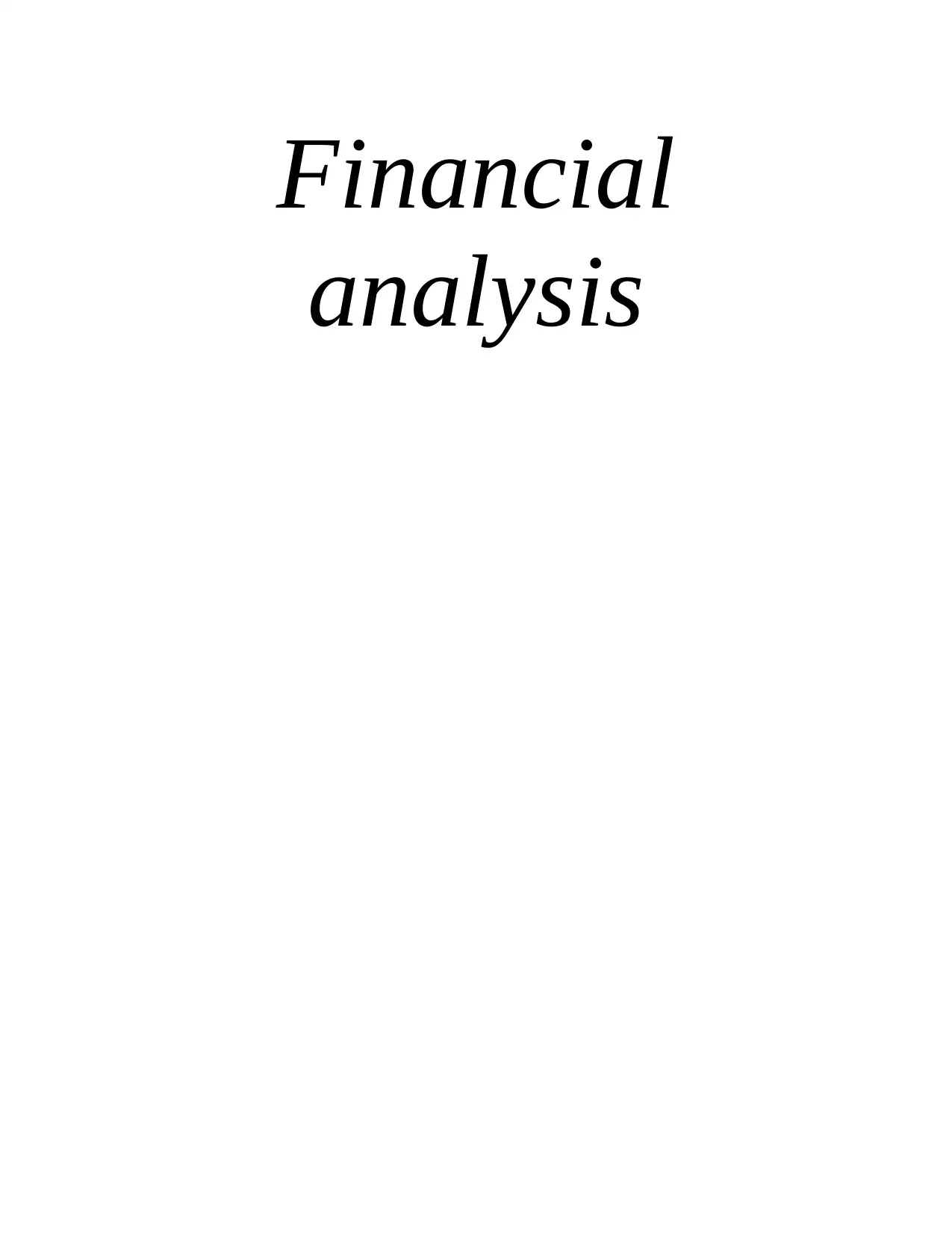
Financial
analysis
analysis
Paraphrase This Document
Need a fresh take? Get an instant paraphrase of this document with our AI Paraphraser
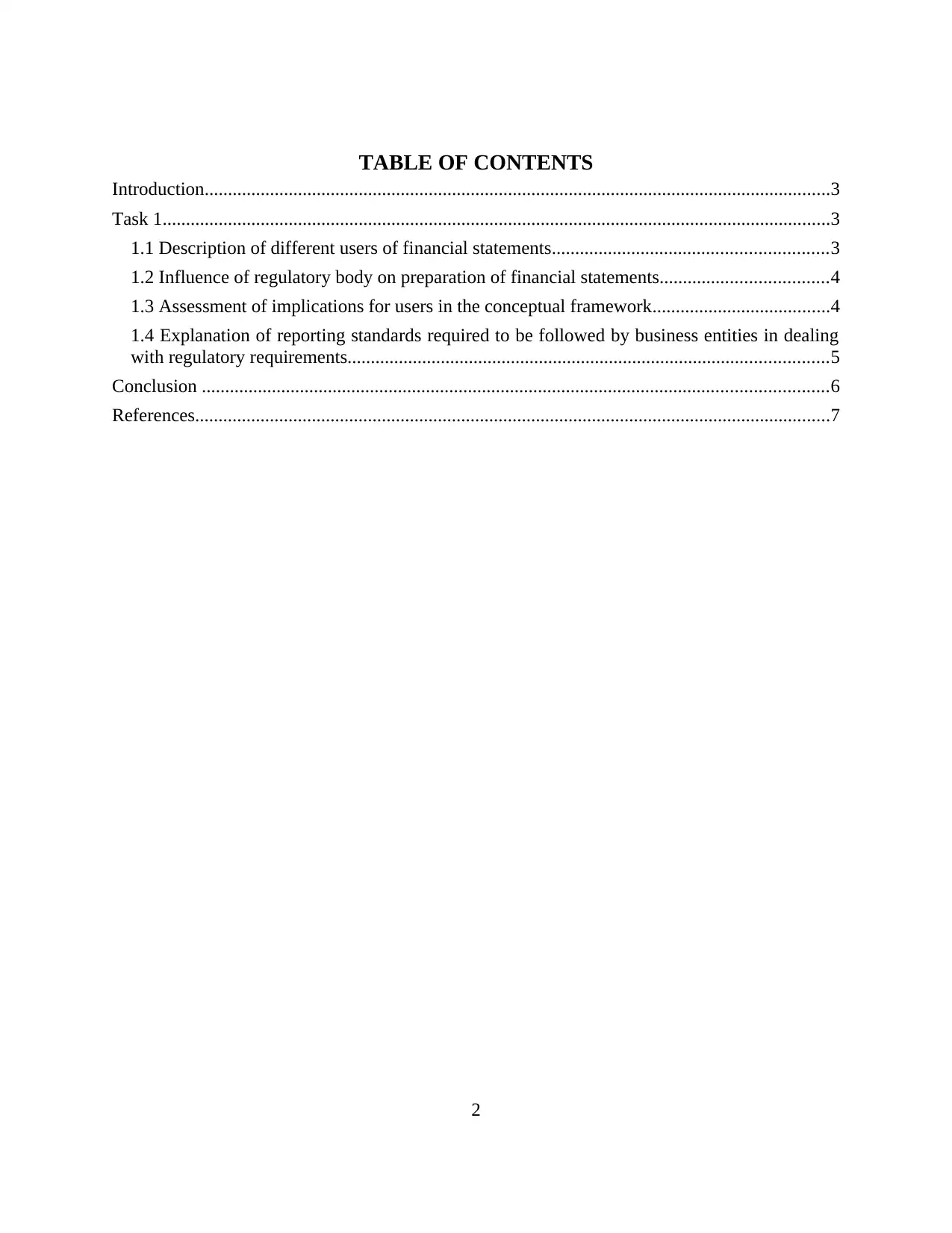
TABLE OF CONTENTS
Introduction......................................................................................................................................3
Task 1...............................................................................................................................................3
1.1 Description of different users of financial statements...........................................................3
1.2 Influence of regulatory body on preparation of financial statements....................................4
1.3 Assessment of implications for users in the conceptual framework......................................4
1.4 Explanation of reporting standards required to be followed by business entities in dealing
with regulatory requirements.......................................................................................................5
Conclusion ......................................................................................................................................6
References........................................................................................................................................7
2
Introduction......................................................................................................................................3
Task 1...............................................................................................................................................3
1.1 Description of different users of financial statements...........................................................3
1.2 Influence of regulatory body on preparation of financial statements....................................4
1.3 Assessment of implications for users in the conceptual framework......................................4
1.4 Explanation of reporting standards required to be followed by business entities in dealing
with regulatory requirements.......................................................................................................5
Conclusion ......................................................................................................................................6
References........................................................................................................................................7
2
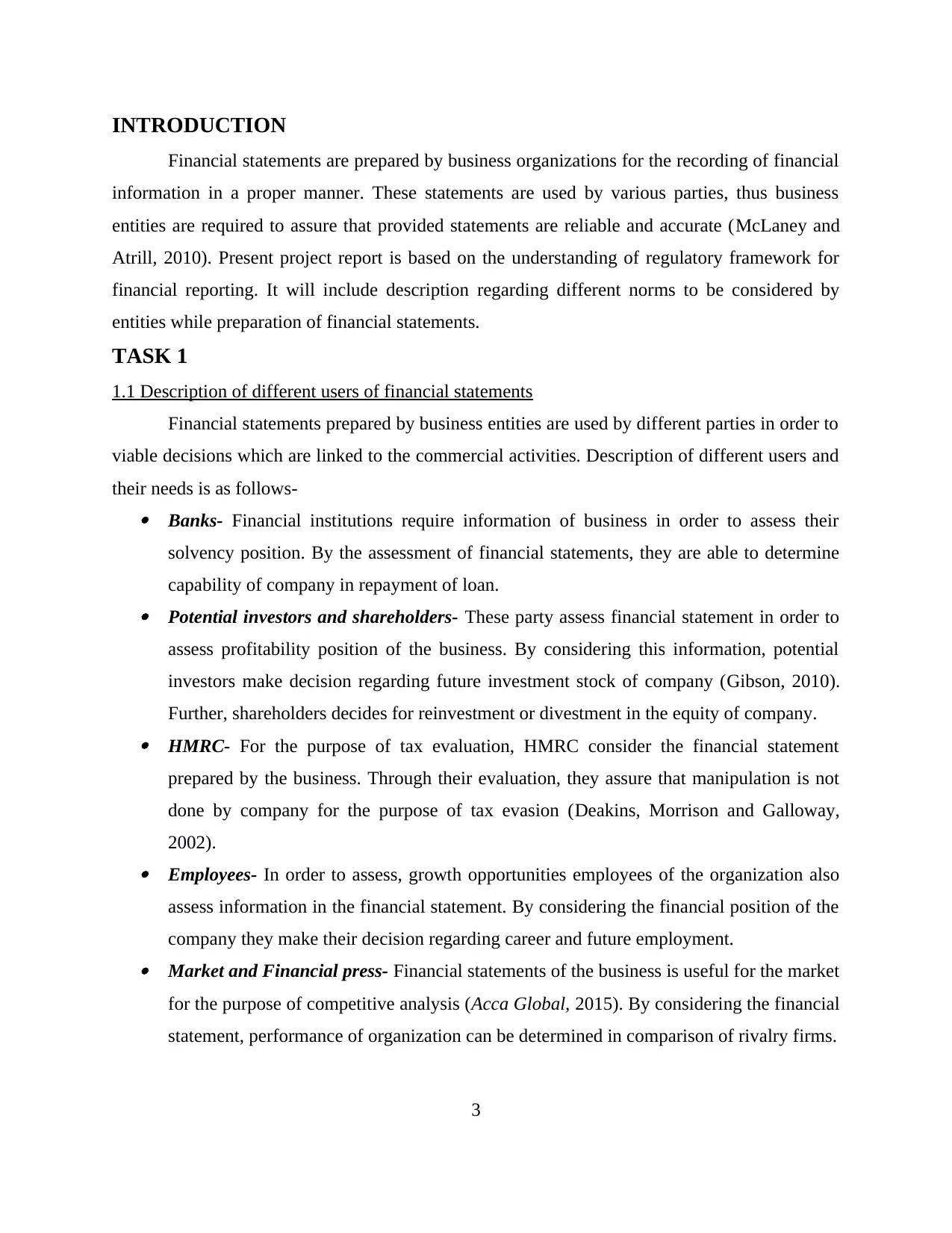
INTRODUCTION
Financial statements are prepared by business organizations for the recording of financial
information in a proper manner. These statements are used by various parties, thus business
entities are required to assure that provided statements are reliable and accurate (McLaney and
Atrill, 2010). Present project report is based on the understanding of regulatory framework for
financial reporting. It will include description regarding different norms to be considered by
entities while preparation of financial statements.
TASK 1
1.1 Description of different users of financial statements
Financial statements prepared by business entities are used by different parties in order to
viable decisions which are linked to the commercial activities. Description of different users and
their needs is as follows- Banks- Financial institutions require information of business in order to assess their
solvency position. By the assessment of financial statements, they are able to determine
capability of company in repayment of loan. Potential investors and shareholders- These party assess financial statement in order to
assess profitability position of the business. By considering this information, potential
investors make decision regarding future investment stock of company (Gibson, 2010).
Further, shareholders decides for reinvestment or divestment in the equity of company. HMRC- For the purpose of tax evaluation, HMRC consider the financial statement
prepared by the business. Through their evaluation, they assure that manipulation is not
done by company for the purpose of tax evasion (Deakins, Morrison and Galloway,
2002). Employees- In order to assess, growth opportunities employees of the organization also
assess information in the financial statement. By considering the financial position of the
company they make their decision regarding career and future employment. Market and Financial press- Financial statements of the business is useful for the market
for the purpose of competitive analysis (Acca Global, 2015). By considering the financial
statement, performance of organization can be determined in comparison of rivalry firms.
3
Financial statements are prepared by business organizations for the recording of financial
information in a proper manner. These statements are used by various parties, thus business
entities are required to assure that provided statements are reliable and accurate (McLaney and
Atrill, 2010). Present project report is based on the understanding of regulatory framework for
financial reporting. It will include description regarding different norms to be considered by
entities while preparation of financial statements.
TASK 1
1.1 Description of different users of financial statements
Financial statements prepared by business entities are used by different parties in order to
viable decisions which are linked to the commercial activities. Description of different users and
their needs is as follows- Banks- Financial institutions require information of business in order to assess their
solvency position. By the assessment of financial statements, they are able to determine
capability of company in repayment of loan. Potential investors and shareholders- These party assess financial statement in order to
assess profitability position of the business. By considering this information, potential
investors make decision regarding future investment stock of company (Gibson, 2010).
Further, shareholders decides for reinvestment or divestment in the equity of company. HMRC- For the purpose of tax evaluation, HMRC consider the financial statement
prepared by the business. Through their evaluation, they assure that manipulation is not
done by company for the purpose of tax evasion (Deakins, Morrison and Galloway,
2002). Employees- In order to assess, growth opportunities employees of the organization also
assess information in the financial statement. By considering the financial position of the
company they make their decision regarding career and future employment. Market and Financial press- Financial statements of the business is useful for the market
for the purpose of competitive analysis (Acca Global, 2015). By considering the financial
statement, performance of organization can be determined in comparison of rivalry firms.
3
⊘ This is a preview!⊘
Do you want full access?
Subscribe today to unlock all pages.

Trusted by 1+ million students worldwide
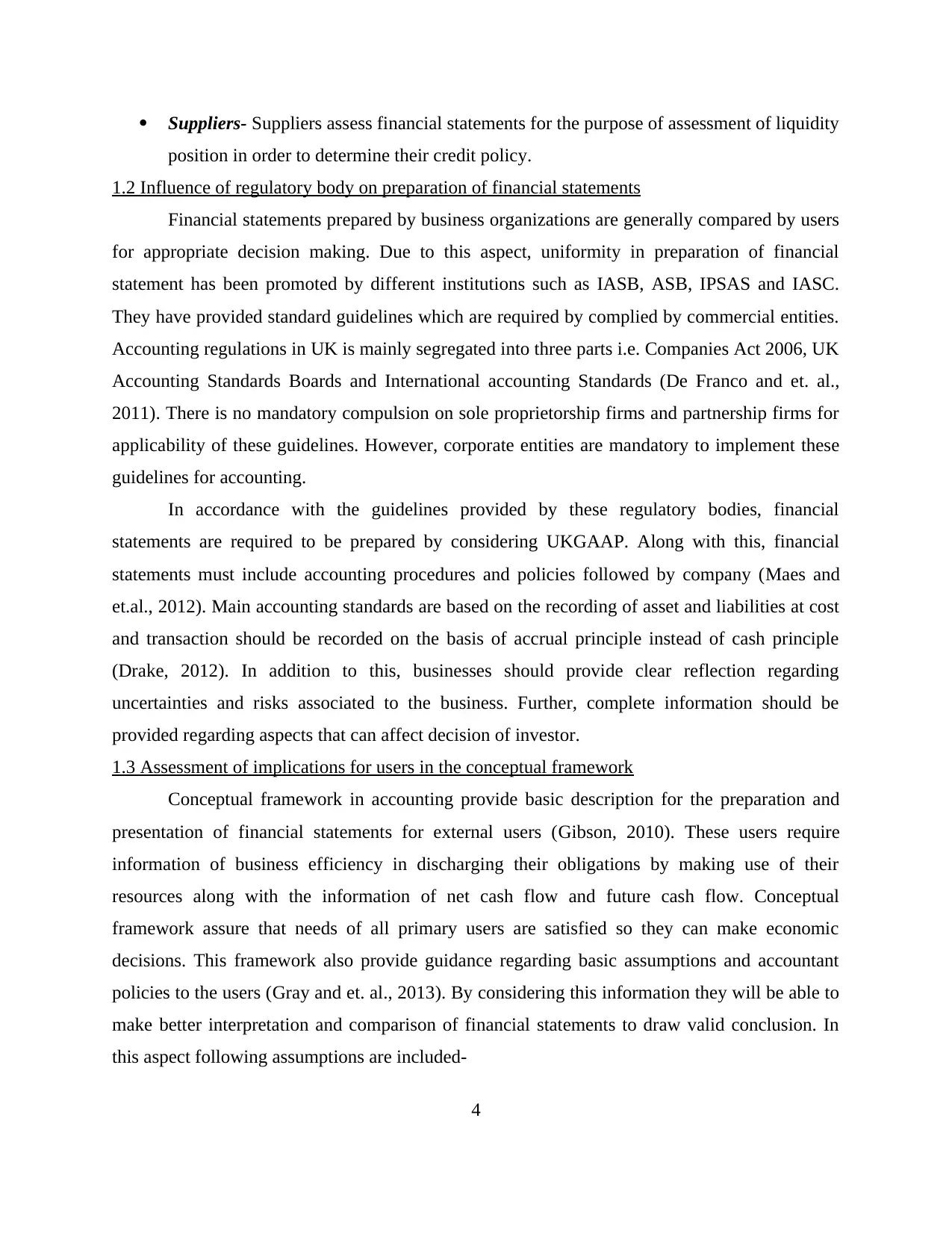
Suppliers- Suppliers assess financial statements for the purpose of assessment of liquidity
position in order to determine their credit policy.
1.2 Influence of regulatory body on preparation of financial statements
Financial statements prepared by business organizations are generally compared by users
for appropriate decision making. Due to this aspect, uniformity in preparation of financial
statement has been promoted by different institutions such as IASB, ASB, IPSAS and IASC.
They have provided standard guidelines which are required by complied by commercial entities.
Accounting regulations in UK is mainly segregated into three parts i.e. Companies Act 2006, UK
Accounting Standards Boards and International accounting Standards (De Franco and et. al.,
2011). There is no mandatory compulsion on sole proprietorship firms and partnership firms for
applicability of these guidelines. However, corporate entities are mandatory to implement these
guidelines for accounting.
In accordance with the guidelines provided by these regulatory bodies, financial
statements are required to be prepared by considering UKGAAP. Along with this, financial
statements must include accounting procedures and policies followed by company (Maes and
et.al., 2012). Main accounting standards are based on the recording of asset and liabilities at cost
and transaction should be recorded on the basis of accrual principle instead of cash principle
(Drake, 2012). In addition to this, businesses should provide clear reflection regarding
uncertainties and risks associated to the business. Further, complete information should be
provided regarding aspects that can affect decision of investor.
1.3 Assessment of implications for users in the conceptual framework
Conceptual framework in accounting provide basic description for the preparation and
presentation of financial statements for external users (Gibson, 2010). These users require
information of business efficiency in discharging their obligations by making use of their
resources along with the information of net cash flow and future cash flow. Conceptual
framework assure that needs of all primary users are satisfied so they can make economic
decisions. This framework also provide guidance regarding basic assumptions and accountant
policies to the users (Gray and et. al., 2013). By considering this information they will be able to
make better interpretation and comparison of financial statements to draw valid conclusion. In
this aspect following assumptions are included-
4
position in order to determine their credit policy.
1.2 Influence of regulatory body on preparation of financial statements
Financial statements prepared by business organizations are generally compared by users
for appropriate decision making. Due to this aspect, uniformity in preparation of financial
statement has been promoted by different institutions such as IASB, ASB, IPSAS and IASC.
They have provided standard guidelines which are required by complied by commercial entities.
Accounting regulations in UK is mainly segregated into three parts i.e. Companies Act 2006, UK
Accounting Standards Boards and International accounting Standards (De Franco and et. al.,
2011). There is no mandatory compulsion on sole proprietorship firms and partnership firms for
applicability of these guidelines. However, corporate entities are mandatory to implement these
guidelines for accounting.
In accordance with the guidelines provided by these regulatory bodies, financial
statements are required to be prepared by considering UKGAAP. Along with this, financial
statements must include accounting procedures and policies followed by company (Maes and
et.al., 2012). Main accounting standards are based on the recording of asset and liabilities at cost
and transaction should be recorded on the basis of accrual principle instead of cash principle
(Drake, 2012). In addition to this, businesses should provide clear reflection regarding
uncertainties and risks associated to the business. Further, complete information should be
provided regarding aspects that can affect decision of investor.
1.3 Assessment of implications for users in the conceptual framework
Conceptual framework in accounting provide basic description for the preparation and
presentation of financial statements for external users (Gibson, 2010). These users require
information of business efficiency in discharging their obligations by making use of their
resources along with the information of net cash flow and future cash flow. Conceptual
framework assure that needs of all primary users are satisfied so they can make economic
decisions. This framework also provide guidance regarding basic assumptions and accountant
policies to the users (Gray and et. al., 2013). By considering this information they will be able to
make better interpretation and comparison of financial statements to draw valid conclusion. In
this aspect following assumptions are included-
4
Paraphrase This Document
Need a fresh take? Get an instant paraphrase of this document with our AI Paraphraser
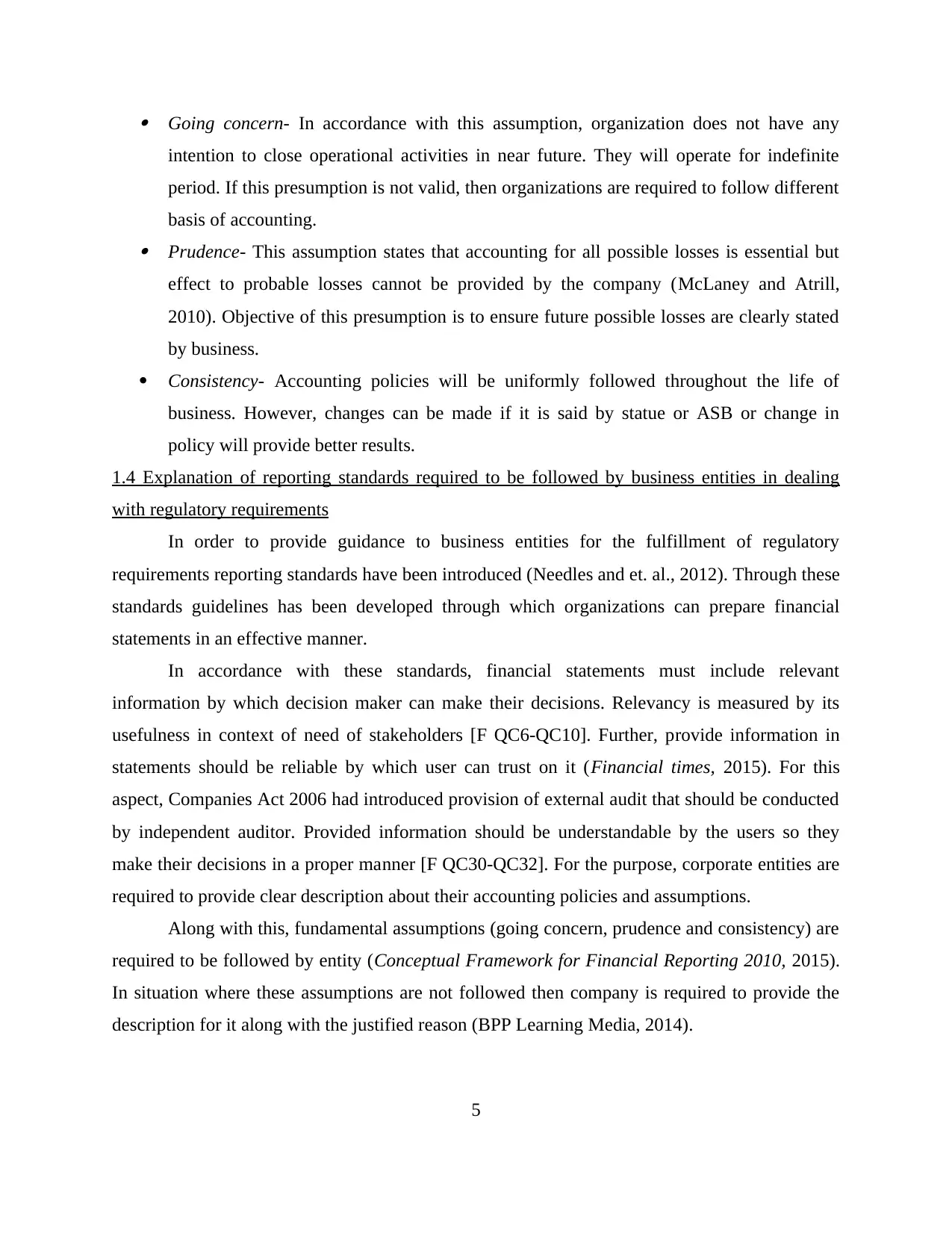
Going concern- In accordance with this assumption, organization does not have any
intention to close operational activities in near future. They will operate for indefinite
period. If this presumption is not valid, then organizations are required to follow different
basis of accounting. Prudence- This assumption states that accounting for all possible losses is essential but
effect to probable losses cannot be provided by the company (McLaney and Atrill,
2010). Objective of this presumption is to ensure future possible losses are clearly stated
by business.
Consistency- Accounting policies will be uniformly followed throughout the life of
business. However, changes can be made if it is said by statue or ASB or change in
policy will provide better results.
1.4 Explanation of reporting standards required to be followed by business entities in dealing
with regulatory requirements
In order to provide guidance to business entities for the fulfillment of regulatory
requirements reporting standards have been introduced (Needles and et. al., 2012). Through these
standards guidelines has been developed through which organizations can prepare financial
statements in an effective manner.
In accordance with these standards, financial statements must include relevant
information by which decision maker can make their decisions. Relevancy is measured by its
usefulness in context of need of stakeholders [F QC6-QC10]. Further, provide information in
statements should be reliable by which user can trust on it (Financial times, 2015). For this
aspect, Companies Act 2006 had introduced provision of external audit that should be conducted
by independent auditor. Provided information should be understandable by the users so they
make their decisions in a proper manner [F QC30-QC32]. For the purpose, corporate entities are
required to provide clear description about their accounting policies and assumptions.
Along with this, fundamental assumptions (going concern, prudence and consistency) are
required to be followed by entity (Conceptual Framework for Financial Reporting 2010, 2015).
In situation where these assumptions are not followed then company is required to provide the
description for it along with the justified reason (BPP Learning Media, 2014).
5
intention to close operational activities in near future. They will operate for indefinite
period. If this presumption is not valid, then organizations are required to follow different
basis of accounting. Prudence- This assumption states that accounting for all possible losses is essential but
effect to probable losses cannot be provided by the company (McLaney and Atrill,
2010). Objective of this presumption is to ensure future possible losses are clearly stated
by business.
Consistency- Accounting policies will be uniformly followed throughout the life of
business. However, changes can be made if it is said by statue or ASB or change in
policy will provide better results.
1.4 Explanation of reporting standards required to be followed by business entities in dealing
with regulatory requirements
In order to provide guidance to business entities for the fulfillment of regulatory
requirements reporting standards have been introduced (Needles and et. al., 2012). Through these
standards guidelines has been developed through which organizations can prepare financial
statements in an effective manner.
In accordance with these standards, financial statements must include relevant
information by which decision maker can make their decisions. Relevancy is measured by its
usefulness in context of need of stakeholders [F QC6-QC10]. Further, provide information in
statements should be reliable by which user can trust on it (Financial times, 2015). For this
aspect, Companies Act 2006 had introduced provision of external audit that should be conducted
by independent auditor. Provided information should be understandable by the users so they
make their decisions in a proper manner [F QC30-QC32]. For the purpose, corporate entities are
required to provide clear description about their accounting policies and assumptions.
Along with this, fundamental assumptions (going concern, prudence and consistency) are
required to be followed by entity (Conceptual Framework for Financial Reporting 2010, 2015).
In situation where these assumptions are not followed then company is required to provide the
description for it along with the justified reason (BPP Learning Media, 2014).
5
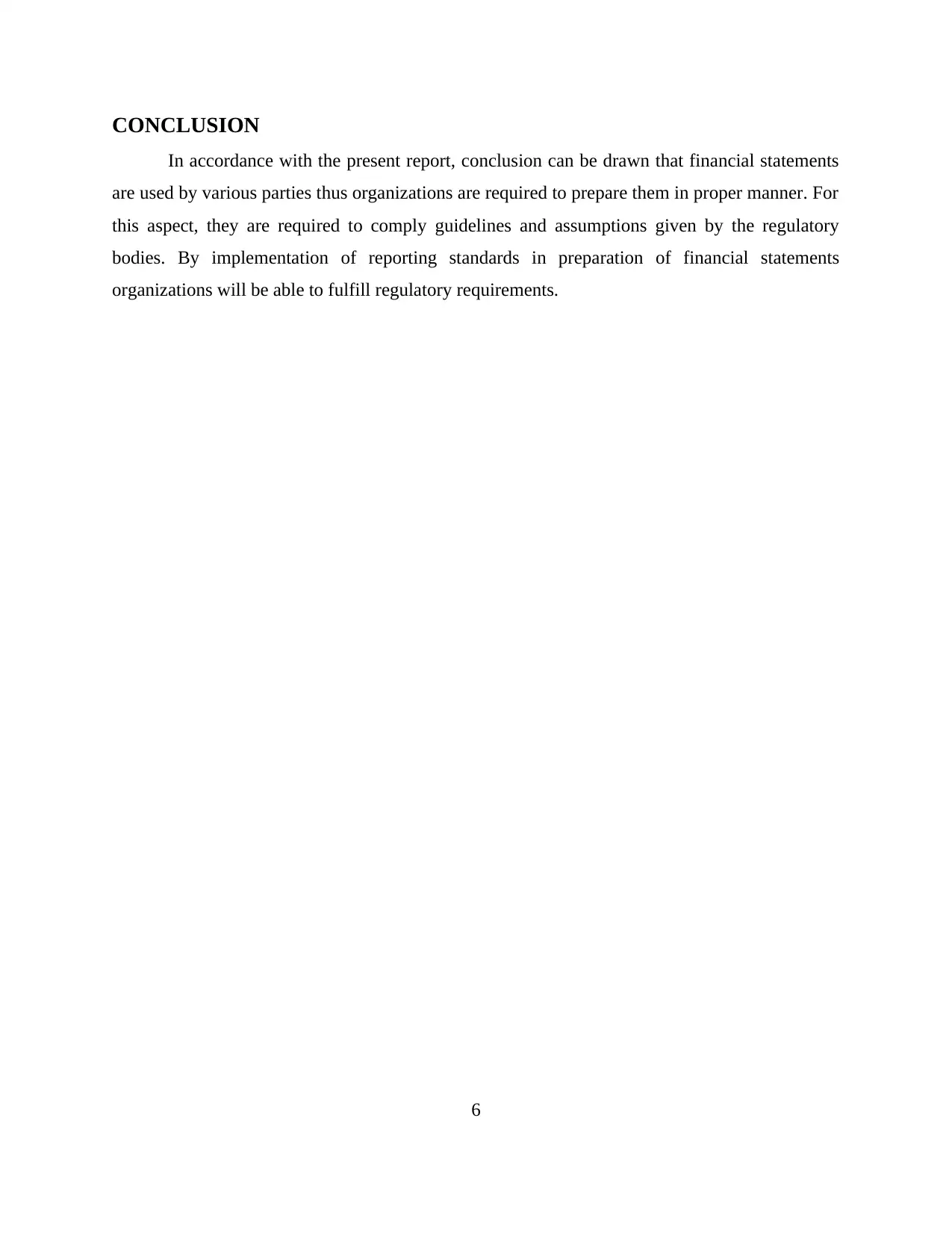
CONCLUSION
In accordance with the present report, conclusion can be drawn that financial statements
are used by various parties thus organizations are required to prepare them in proper manner. For
this aspect, they are required to comply guidelines and assumptions given by the regulatory
bodies. By implementation of reporting standards in preparation of financial statements
organizations will be able to fulfill regulatory requirements.
6
In accordance with the present report, conclusion can be drawn that financial statements
are used by various parties thus organizations are required to prepare them in proper manner. For
this aspect, they are required to comply guidelines and assumptions given by the regulatory
bodies. By implementation of reporting standards in preparation of financial statements
organizations will be able to fulfill regulatory requirements.
6
⊘ This is a preview!⊘
Do you want full access?
Subscribe today to unlock all pages.

Trusted by 1+ million students worldwide
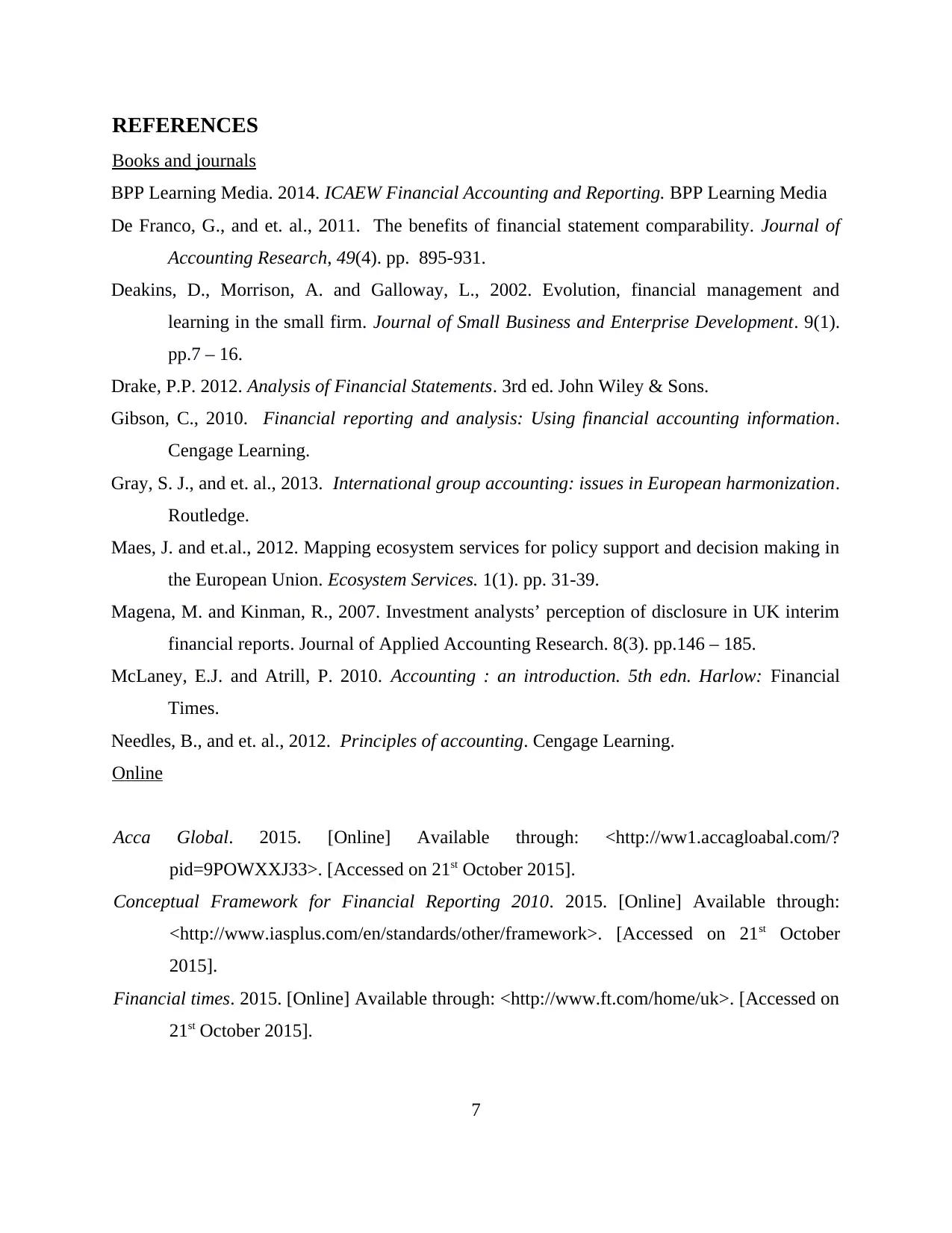
REFERENCES
Books and journals
BPP Learning Media. 2014. ICAEW Financial Accounting and Reporting. BPP Learning Media
De Franco, G., and et. al., 2011. The benefits of financial statement comparability. Journal of
Accounting Research, 49(4). pp. 895-931.
Deakins, D., Morrison, A. and Galloway, L., 2002. Evolution, financial management and
learning in the small firm. Journal of Small Business and Enterprise Development. 9(1).
pp.7 – 16.
Drake, P.P. 2012. Analysis of Financial Statements. 3rd ed. John Wiley & Sons.
Gibson, C., 2010. Financial reporting and analysis: Using financial accounting information.
Cengage Learning.
Gray, S. J., and et. al., 2013. International group accounting: issues in European harmonization.
Routledge.
Maes, J. and et.al., 2012. Mapping ecosystem services for policy support and decision making in
the European Union. Ecosystem Services. 1(1). pp. 31-39.
Magena, M. and Kinman, R., 2007. Investment analysts’ perception of disclosure in UK interim
financial reports. Journal of Applied Accounting Research. 8(3). pp.146 – 185.
McLaney, E.J. and Atrill, P. 2010. Accounting : an introduction. 5th edn. Harlow: Financial
Times.
Needles, B., and et. al., 2012. Principles of accounting. Cengage Learning.
Online
Acca Global. 2015. [Online] Available through: <http://ww1.accagloabal.com/?
pid=9POWXXJ33>. [Accessed on 21st October 2015].
Conceptual Framework for Financial Reporting 2010. 2015. [Online] Available through:
<http://www.iasplus.com/en/standards/other/framework>. [Accessed on 21st October
2015].
Financial times. 2015. [Online] Available through: <http://www.ft.com/home/uk>. [Accessed on
21st October 2015].
7
Books and journals
BPP Learning Media. 2014. ICAEW Financial Accounting and Reporting. BPP Learning Media
De Franco, G., and et. al., 2011. The benefits of financial statement comparability. Journal of
Accounting Research, 49(4). pp. 895-931.
Deakins, D., Morrison, A. and Galloway, L., 2002. Evolution, financial management and
learning in the small firm. Journal of Small Business and Enterprise Development. 9(1).
pp.7 – 16.
Drake, P.P. 2012. Analysis of Financial Statements. 3rd ed. John Wiley & Sons.
Gibson, C., 2010. Financial reporting and analysis: Using financial accounting information.
Cengage Learning.
Gray, S. J., and et. al., 2013. International group accounting: issues in European harmonization.
Routledge.
Maes, J. and et.al., 2012. Mapping ecosystem services for policy support and decision making in
the European Union. Ecosystem Services. 1(1). pp. 31-39.
Magena, M. and Kinman, R., 2007. Investment analysts’ perception of disclosure in UK interim
financial reports. Journal of Applied Accounting Research. 8(3). pp.146 – 185.
McLaney, E.J. and Atrill, P. 2010. Accounting : an introduction. 5th edn. Harlow: Financial
Times.
Needles, B., and et. al., 2012. Principles of accounting. Cengage Learning.
Online
Acca Global. 2015. [Online] Available through: <http://ww1.accagloabal.com/?
pid=9POWXXJ33>. [Accessed on 21st October 2015].
Conceptual Framework for Financial Reporting 2010. 2015. [Online] Available through:
<http://www.iasplus.com/en/standards/other/framework>. [Accessed on 21st October
2015].
Financial times. 2015. [Online] Available through: <http://www.ft.com/home/uk>. [Accessed on
21st October 2015].
7
1 out of 7
Related Documents
Your All-in-One AI-Powered Toolkit for Academic Success.
+13062052269
info@desklib.com
Available 24*7 on WhatsApp / Email
![[object Object]](/_next/static/media/star-bottom.7253800d.svg)
Unlock your academic potential
Copyright © 2020–2025 A2Z Services. All Rights Reserved. Developed and managed by ZUCOL.





